|
|
Dear Wisconsin beekeepers and those interested in honey bees and wild pollinators:
This is the fourth quarterly update of 2023 from the Wisconsin Department of Agriculture, Trade and Consumer Protection (DATCP) apiary program. Please let us know how you use this newsletter. Send any feedback, questions, or ideas for future updates to Frances.Hegarty@wisconsin.gov.
|
|
|
Every August and September, it seems to be yellowjacket season in Wisconsin. During this time, it is normal to see social wasps like yellowjackets, paper wasps, and bald-faced hornets. These insects build up their numbers throughout summer, and one nest can have as many as 4,000 individuals. Yellowjackets live until fall, when only the queen overwinters to form a new colony the following year. During summer, yellowjackets feed on larvae, but once the queen leaves, food becomes scarce and that is when they may become aggressive with humans. The best advice for avoiding stings is to minimize putting sugary drinks, fruit, pet food, bird feeders, or other attractive substances outdoors near where you spend time in the yard.
Despite the bald-faced hornet’s name, it is also a type of predatory social wasp, like the yellowjacket. However, unlike the yellowjacket, it is white and black, rather than yellow and black, and it can be more aggressive towards humans.
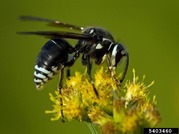
Many social wasps defend their nests by stinging intruders. However, after a few hard frosts, social wasp colonies die each fall. A few weeks of fall-like weather should be enough to control these colonies.
|
Picture (above): Bald-faced hornet; David Cappaert, Bugwood.org
Picture (above): Giant cicada killer; Russ Ottens, University of Georgia, Bugwood.org
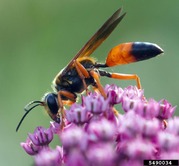
The giant cicada killer wasp and the great golden digger wasp have more in common than lengthy common names. They both nest in the ground, are not aggressive towards humans, are beneficial insects, and have been confused with invasive hornets, like the large Northern Giant Hornet detected in Washington state in recent years.
|
Picture (above): Great golden digger wasp; David Cappaert, Bugwood.org
Recently, near Savannah, Georgia, a new invasive hornet named the yellow-legged hornet (YLH) was detected in the U.S. for the first time. Two colonies (and their nests) have been detected and eradicated so far. If established, this invasive, non-native pest could become a major threat to honey bees and native pollinators. More information about YLH is available from the Georgia Department of Agriculture and the U.S. Department of Agriculture (USDA).
While it is important to know how to tell the difference between native bees and wasps and emerging pests, we encourage you to report suspected invasive hornet finds to your state apiarist.
Find more information in the UMN Wasps and Bees webpage.
See these UW-Madison visual ID guides:
|
|
|
Houdini flies (Cacoxenus indagator) are an invasive pest of mason bees. Mason bees are solitary bees and are great pollinators of fruit tree crops, like apples. Due to their efficient pollination, mason bees are managed pollinators. This Wisconsin Bee Identification Guide includes a brief description of mason bees. A type of mason bee, the blue orchard bee (BOB, Osmia lignaria, mason orchard bee) is native to Wisconsin.
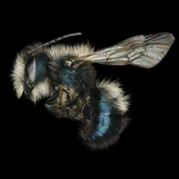
As its name suggests, BOB also efficiently pollinates trees in fruit orchards. Houdini flies threaten native mason bees, like BOB, and the managed mason bee industry. However, we do not know how widespread Houdini flies are in the U.S., or all the species impacted by it.
|
Picture: Blue orchard bee (BOB); Chelsey Ritner, USU, USDA
Houdini flies starve larval mason bees by laying eggs in the mason bee nesting cavity and eating all of the pollen/nectar food stores the mother mason bee left for the larval mason bees. The newly emerged adult Houdini flies then break out of the nesting cavity. More information about this process is available here.
The USDA is now accepting specimens of Houdini flies to assess their current range and the species that they impact. If you work with mason bees, please spread the word and submit any Houdini fly specimens to the USDA for official confirmation. Detailed instructions about how to submit a specimen for a USDA confirmation of a preliminary pest ID are located at this USDA webpage.
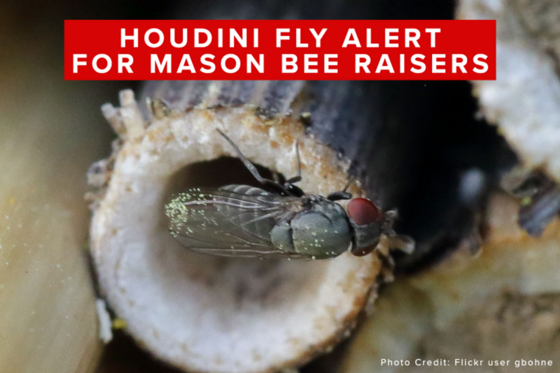
|
|
|
Successfully overwintering honey bees in Wisconsin can be complicated by our cold winters. Previous scientific studies have found strong correlations between winter colony losses and levels of Varroa mites, the viruses they vector, geographic location, and genotype of the honey bees. So far, there has not been enough scientific research to tease out exactly how each of these factors influence overwintering success. But these results have led to many "dos" and “don’ts” for overwintering bees in Wisconsin.
Here are some of the most important things you should do to help your bees survive the winter.
Overwinter healthy colonies
Monitor and control for Varroa mites using Integrated Pest Management (IPM) tactics
Follow pesticide labels, and remember, “The label is the law”
Insulate and ventilate each hive and, if appropriate, provide a windbreak
- Keep each hive behind a windbreak or move them inside a shed or barn for the winter
- Make sure each hive can ventilate out excess moisture
- Add ventilation near the top of the hive to reduce condensation
Add an entrance reducer or mouse guard in the fall
The University of Minnesota Bee Lab has an excellent manual titled “Beekeeping in Northern Climates” outlining how to overwinter bees in our conditions.
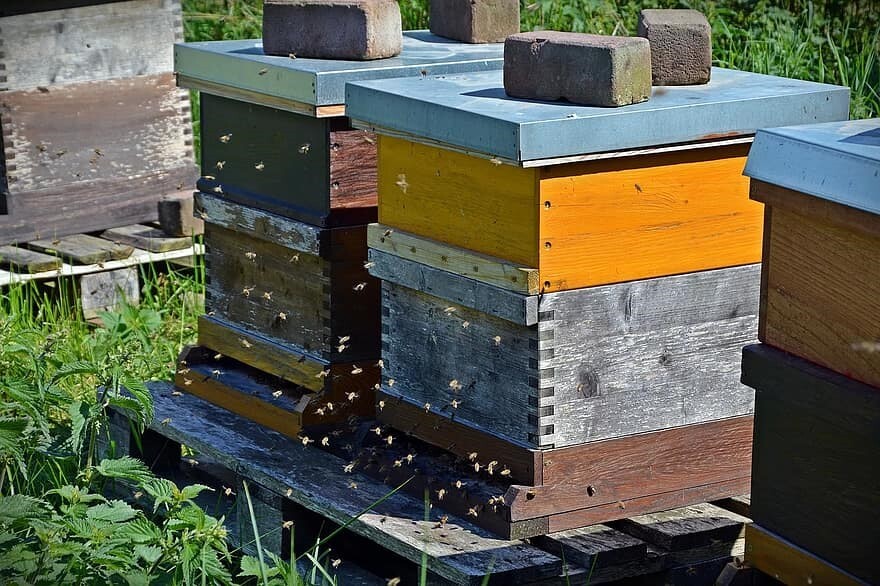 Photo: honey bee hives (from Creative Commons online).
|
|
|
Although pesticide overuse has long been suspected as a key factor involved in honey bee and wild pollinator declines, research quantifying impacts has been lacking. In response, a group of researchers (Pecenka, Ingwell, Krupke, & et al., 2023) recently tried to get at this question by planting pollinator-dependent watermelon surrounded by corn grown under different management regimes. They compared the growth and survival of managed honey bees and bumble bees associated with the watermelon, as well as the diversity of wild pollinators when the fruit crop was surrounded by seed corn managed using conventional methods, vs. integrated pest management (IPM), which only treated corn and watermelon with pesticides in response to scouting data and pest thresholds.
The IPM practices studied in this research included corn seed that was only treated with fungicides. Additionally, the watermelon crop only (infrequently) received an insecticide treatment for its primary pest (striped cucumber beetle) when the beetle exceeded the IPM threshold of five beetles per plant. In this study, Varroa mite levels were not affected by conventional management or IPM practices. However, honey bee hives in the IPM system had lower mortality and greater overwintering success compared to the conventionally managed hives.
Overall, results showed that IPM /reduced pesticide use led to higher growth and lower mortality of honey bees and bumble bees, and a dramatic 147% increase in the abundance and 128% increase in species richness of wild pollinator species. Moreover, a lower concentration of neonicotinoid pesticides were found in the hives of the managed honey bees and bumble bees. This research shows that encouraging farmers to employ IPM and judicious use of pesticides in growing corn and other commodities can significantly improve pollinator health. That in turn can benefit nearby fruit and vegetable crops.
Photo (above): Honey bee hives, in a fall field.
Reference:
Pecenka, J. R., Ingwell, L. L., Krupke, C. H., et al. (2023). Implementing IPM in crop management simultaneously improves the health of managed bees and enhances the diversity of wild pollinator communities. Scientific Reports 13.
|
|
|
The return of cooler weather often means it will soon be time for honey bee meetings. Here is a reminder of the dates for two different meetings or workshops.
Fall 2023 WHPA Convention
DATCP staff plan to provide our annual report at the Wisconsin Honey Producers (WHAP) Fall Convention. The convention will be held from November 2–4, 2023, in Wisconsin Dells. Please see the WHPA webpage for details.
WTO Workshop – Honey and Food Fraud
The World Trade Organization (WTO) has an online workshop on food fraud this December, on Monday, December 11, 2023, and Tuesday, December 12, 2023. A panel discussing honey fraud and food fraud is scheduled for Tuesday, December 12, 2023. This discussion will be streamed live via YouTube at https://www.youtube.com/watch?v=cj-7vwERfDg. Upcoming WTO live steams and their archived videos are also available.
|
|
|
|
|